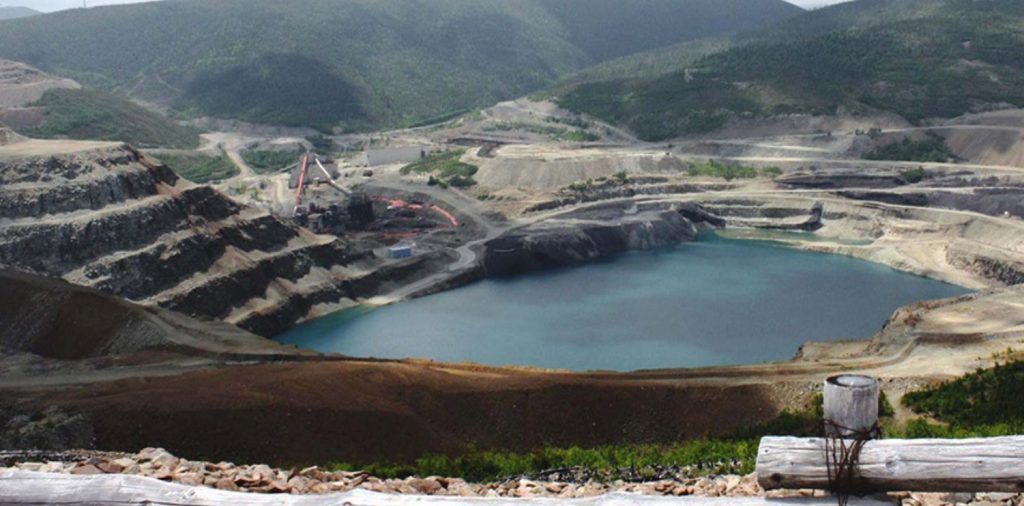Osisko Metals drills 0.55% copper over 300 metres at Gaspe, Quebec

Osisko Metals Inc. [OM-TSXV; OMZNF-OTCQX; OB51-FSE] reported the final drilling results from the 2022 program at the Gaspe copper project, located in the Gaspe Peninsula of Quebec. Five of the six holes reported below were collared along the periphery of the historical Mount Copper open pit, including one low-angle directional drill hole (30-1003) oriented to crosscut the higher-grade mineralization located below the bottom of the existing open pit, and one hole (30-992) was collared on the eastern flank of Mount Copper.
Highlights: Drill hole 30-1003, drilled shallowly toward the west under the existing pit, intersected 300 metres grading 0.55% (Cu), 3.59 g/t silver (Ag) and 0.02% molybdenum (Mo), followed by an additional 244.5 metres grading 0.32% Cu, 1.41 g/t Ag and 0.02% Mo. This hole extended mineralization beyond the lower limit of the current block model by 107 metres.
Drill hole 30-0998A, drilled shallowly toward the west under the existing pit, intersected 255 metres grading 0.34% Cu, 2.73 g/t Ag and 0.02% Mo. This hole ended within the limit of the block model and met the expected grades.
Drill hole 30-1010, drilled toward the south under the existing pit, intersected 304.5 metres grading 0.54% Cu, 3.43 g/t Ag and 0.04% Mo. This hole extended mineralization 122 metres above the block model and ended in weak mineralization, extending 56 metres beyond the lower limit of the block model.
Drill hole 30-1015, drilled toward the east between Mount Copper and the existing pit intersected 300 metres grading 0.18% Cu, 1.10 g/t Ag and 0.01% Mo, followed by an additional 150 metres grading 0.33% Cu, 2.40 g/t Ag and 0.02% Mo. This hole extended mineralization beyond the lower limit of the block model by 117 metres.
Robert Wares, chairman and CEO, commented: “The 2022 infill drilling was successful in better defining and potentially expanding the in-pit resource at Mount Copper. Drilling will resume in June and the upcoming summer program will allow conversion of the 2022 inferred mineral resource estimate to the measured and indicated category, in preparation for an eventual feasibility study. The company also plans on drill testing the deep-seated Porphyry Mountain deposit in 2023, as well as residual high-grade massive sulphide mineralization previously reported in the E zone.”
Intersections of less than 10 metres are not reported. The maximum internal dilution of reported intersections (below calculated composites of 10.5 metres grading minimum of 0.16% Cu) is 5.0 metres.
Drill hole 30-0998 intersected minor mineralization and failed in a rubble zone at a depth of 214.5 metres. It was re-drilled as hole 30-0998A.
Drill hole 30-1003 was drilled perpendicular to well-developed NNW-striking joint set to test potential higher-grade mineralization associated with these joints under the historical pit. This hole intersected 300 metres of higher-grade mineralization that was cross-cut by poorly mineralized, late-stage quartz-feldspar porphyry dykes.
Drill hole 30-998A was also drilled perpendicular to the NNE joint set and returned 255 metres of average-grade mineralization.
Drill hole 30-1010 was collared at the northern margin of the pit and was oriented sub-parallel to the NNE joint set, also intersecting higher grades over 304 metres.
Five of the six drill holes extended mineralization beyond the current block model used for the 2022 Mineral Resource Estimate. The porphyry-skarn style stockwork mineralization at Mount Copper is characterized by large, continuous copper mineralization radiating from the central primary source of mineralizing fluids known as the Mount Copper Dyke Swarm.
The Company is also in the process of acquiring, from Glencore Canada Corp., a 100% interest in the past-producing Gaspe Copper Mine, located near Murdochville in the Gaspe peninsula of Quebec. The company is currently focused on resource evaluation of the Mount Copper Expansion Project that hosts a NI43-101 Inferred Resource of 456 Mt grading 0.31% Cu. Gaspe Copper hosts the largest undeveloped copper resource in Eastern North America, strategically located near existing infrastructure in the mining-friendly province of Quebec.
